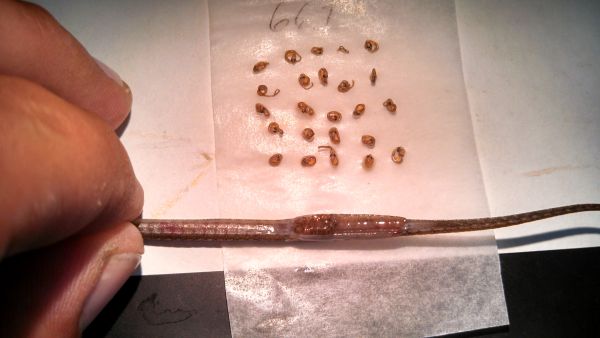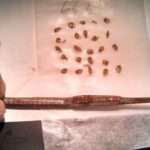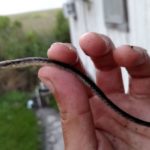
Some fish just can’t seem to get their romantic life straight. For most fish it’s enough for females and males to discharge eggs and sperm into the water. Sometimes they do it in a constructed nest, but most of the time it’s in open water.
The young of nest-builders usually get a little protection from male fish, but soon they are in open water, as well, and at the mercy of a host of predators just as those that hatch from egg scatterers.
These are called oviparous spawners, with the “ova” part of the name derived from Latin for “egg” and the “parous” part meaning “to bring forth.”
A few but still significant number are ovoviparous, which means that rather than release unfertilized eggs into the environment for fertilization, the females retain the eggs in their body until they mate with a male. The “vi” stuck in the middle of the name means “live” in Latin.
With this form of reproduction, the male fish inserts its sperm into the female, where it fertilizes the retained eggs. The female then holds the eggs through hatching and until the young fish have absorbed their yolk sacs. Only then does the female give “birth” to the living young.
And then there are the oddballs.
In these, a female, naturally enough, produces the eggs — but rather than broadcasting them in the water or holding them until the male fertilizes them in her body, the adult inserts them into the male during mating.
The male fertilizes them in his own body and holds the eggs and newly hatched young.
The “pregnant” male then gives “birth” to the young after they have absorbed their yolk sacs.
Louisiana (and the rest of the Gulf of Mexico states) hosts a family of fishes called “Syngnathidae” that specializes in this form of reproduction.
This is the sea horse and pipefish family. Seven pipefish and two sea horses, as well as two in-between-looking species of pipehorses are found here.
One feature they all share is a tiny mouth set on the end of a long, tube-shaped snout. The shape of the mouth makes biting foods difficult; they feed by using a slurping-suction action.
One of the most-interesting members of the family is the gulf pipefish, which carries the scientific name of Syngnathus scovelli. Greek is the origin of the genus name Syngnathus and means “grown together jaw,” in reference to the largely immovable jaws. The species name, scovellis, was created in honor of Josiah T. Scovell (1841-1915), a medical doctor, and amateur naturalist and historian who helped collect the first of the species to be recognized by science.
The gulf pipefish ranges from the state of Georgia in the U.S. southward through the Gulf of Mexico to Brazil in South America. It is the only member of its family in the Gulf that commonly lives in freshwater, as well as brackish and marine waters.
In Louisiana, they have been documented as far inland as Lake St. John, 290 river miles from the Gulf. They are quite common in the Mississippi River as far north as Baton Rouge, where they can be found in submerged grasses on the river’s levees and battures when the river is in flood stage.
Recently, Nicholls State marine and environmental biology graduate student Chris Levron studied the reproductive differences in nine populations of this fish from fresh, brackish and marine waters in the state.
He removed eggs from females and from male pouches, and weighed them. Both males and females from freshwater populations had larger egg masses than those from saltwater. He also found the both sexes matured at a smaller size in saltwater than freshwater.
As a general rule, Levron noted, fish with many and smaller eggs are trading off poorer survivability of their young for an increase in the numbers of young they produce. Fish with fewer but larger eggs maximize the chance of any individual baby surviving at the expense of producing fewer babies.
He explained that, in theory, fish living in habitats that stress them less and have more food available usually produce more and smaller eggs. With gulf pipefish, the struggle to maintain proper salt balance in the bodies of what are essentially saltwater fish might likely be a stress factor. So could less food being available in freshwater than saltwater.
Gulf pipefish are small fish, with a maximum size of 7 inches. They can mature as small as 2.2 inches long. Although the males have to do all the egg brooding, females are generally larger than males.
From 150 to 175 eggs are typically the maximum found in males, although the brood pouch of one large male from Georgia contained 296 embryos. Males will carry eggs from more than one female in their pouches at one time.
“Females can produce eggs faster than males can brood them,” Levron explained. Males will brood as many as three clutches per year, and mating takes place throughout the year.
Mating courtship is elaborate and initiated by the female. Called “liebenspiel” (“love play” in German), the pair swims nose up and tail down, bobbing at the surface and wrapping their bodies around each other.
After mating, the male rubs the brood pouch on its belly along the bottom. This might be done to move the eggs from the front to the rear of the pouch. Within the pouch, the bright-orange eggs are arranged in neat rows.
Inside the pouch, the eggs are bathed in a liquid derived from the male’s blood. They hatch in two weeks. Gulf pipefish have a short life span after hatching, with most references saying one year, although one claims three years.
In fresh and brackish waters, gulf pipefish are always found in beds of water plants. In marine waters, they will be found in beds of algae, as well as in sea grasses where they are present.
They feed during daylight hours and are predators, consuming copepods, ostracods, amphipods, tanaids, and isopods — all tiny shrimp-like crustaceans. Plants are not a food of choice.
Gulf pipefish are oddly shaped creatures — long and slender, with a body and tail set in boney rings. Pipefish have no pelvic fins (the paired fins found near the anus of most fish) and only a tiny rounded tail fin.
Body color is brown or dark olive green, with vertical, silvery bars set parallel to each other on their sides.
Its closest relative in Louisiana waters is the chain pipefish, commonly found in brackish marsh weed beds. The chain pipefish can be separated from its cousin by its snout being longer than that of the gulf pipefish.




